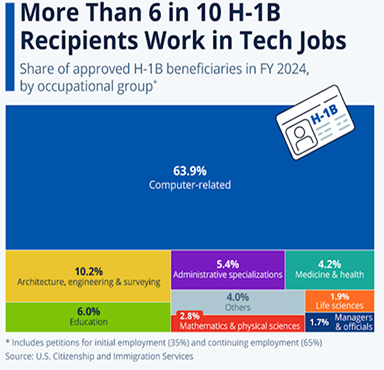The White House’s September 19, 2025, proclamation, “Restriction on Entry of Certain Nonimmigrant Workers,” introduces a $100,000 fee for many new H-1B visa petitions for workers outside the U.S., effective September 21, 2025, for one year. This policy spares existing H-1B visas, renewals, and previously filed petitions, but for tech companies reliant on global talent, it raises urgent questions: How will this impact hiring and project delivery? What strategies can keep innovation on track?
This article explores the challenges, risks, and actionable solutions to navigate these restrictions, with insights from Jaxel on maintaining stability and growth.

Source: Pew Research Center, “Trends in H-1B approvals since 2000”.
1. Who’s Impacted Affected Visa Categories
The proclamation targets H-1B visas for workers outside the U.S., requiring a $100,000 fee per new petition.
Key details:
- Exemptions: Existing H-1B holders, renewals, and petitions deemed in the “national interest” (e.g., critical industries or roles) are unaffected, pending further guidance from USCIS or the Department of State.
- Scope: Other visa types (L-1, TN, O-1) are not explicitly mentioned, but clarifications may emerge.

Source: Statista, “More Than 6 in 10 H-1B Recipients Work in Tech Jobs,” 2024.
2. Industries & Roles Most Vulnerable
The technology sector is the most exposed, given its heavy reliance on H-1B talent for:
- Software engineering
- Data science & AI/ML
- Cloud architecture & DevOps
- Infrastructure & cybersecurity
These roles are already under pressure due to the global AI talent shortage. The visa restriction compounds that gap – slowing innovation, delaying products, and increasing hiring costs.
3. Key Risks for Businesses
1. Talent Shortages
Restricted access to specialized skills can leave mission-critical projects understaffed. Without AI and software expertise, innovation slows and competitive advantage erodes.
2. Project Delays
Product roadmaps, feature releases, and client deliverables face risk as hiring pipelines stall. Each month of unfilled roles can translate into lost market share and missed opportunities.
3. Rising Domestic Hiring Costs
With a tighter local labor pool, firms may need to offer higher salaries, bonuses, or retraining. These rising costs can quickly erode margins — particularly for firms that depend on global staffing flexibility.
4. What Businesses Can Do
While the policy raises new hurdles, agile organizations can pivot effectively. Here are five proven strategies to maintain momentum and access top technical talent.
1. Strengthen Remote & Distributed WorkMany tech roles can be performed remotely.
Instead of relocating international hires, companies can:
- Build distributed teams abroad, keeping engineers in their home countries.
- Integrate them seamlessly via secure cloud platforms and collaboration tools.
- Adopt “remote-first” operating models to expand reach while minimizing legal exposure
2. Explore Nearshore & Offshore Partnerships.
Establishing engineering hubs in nearshore regions (e.g., Latin America, Eastern Europe, Eurasia) provides access to skilled developers within compatible time zones.
Benefits include:
- Cost efficiency
- Faster team setup
- Access to diverse, specialized talent pools
3. Upskill & Retain Domestic Talent.
Internal reskilling programs build long-term resilience.
- Focus on AI, cloud, data, and cybersecurity.
- Partner with universities or bootcamps for targeted upskilling.
- Recognize and reward continuous learning to retain top performers.
4. Use Alternative Visa Pathways.
Other U.S. visa categories may offer flexibility:
While the policy raises new hurdles, agile organizations can pivot effectively. Here are five proven strategies to maintain momentum and access top technical talent.

5. Lean on AI & Automation.
To offset human-capital constraints, invest in intelligent tools that boost team productivity.
- AI copilots for development and QA
- Automated testing & CI/CD pipelines
- Predictive analytics for operations
This approach lets you scale output without expanding headcount.
5. How Jaxel Can Help
At Jaxel, we understand that navigating sudden policy changes can feel overwhelming. That’s why we’ve built flexible models to help businesses keep momentum even when immigration pathways narrow.

1. Assemble Offshore Teams
We can quickly build and manage offshore engineering teams for you, ensuring continuity of projects without delays. With access to a wide talent pool, we match the right skills to your business needs.
Key Advantages:
- Speed to Market: Rapid team setup so your projects don’t stall.
- Cost Efficiency: Access to top engineering talent at competitive global rates.
- Scalability: Easily scale teams up or down based on project demands.
- Specialized Skills: Tap into niche expertise in areas like AI/ML, cloud, DevOps, and cybersecurity.
- Seamless Integration: Our offshore engineers work as an extension of your in-house team, aligned with your tools, culture, and processes.
2. Digital Custom Centers in Eurasia
Jaxel has experience working with Digital Custom Centers across Eurasia, helping businesses leverage them as powerful hubs for engineering and product development.
What is a Digital Custom Center?
A Digital Custom Center is a dedicated offshore unit that functions as an extension of your in-house team. Instead of outsourcing to multiple vendors, you gain a centralized, tailored center of skilled engineers who work exclusively on your company’s priorities. These centers provide the focus and alignment of an in-house team combined with the scalability and cost advantages of offshore operations.
Key Benefits:
- Stability & Focus: Teams are aligned only with your goals and workflows.
- Scalability: Expand capacity quickly without the overhead of traditional hiring.
- Cost Efficiency: Optimize budgets by building in regions with high talent availability and lower costs.
3. Project-Specific Engineering Support
Need specialized engineers for a specific period or project phase? We can provide vetted experts who integrate directly into your workflows, helping you deliver on time without long-term commitments or immigration hurdles.
Why Businesses Should Consider This Approach:
- Flexibility Without Overhead: Instead of hiring full-time staff for short-term needs, you can bring in experts only when required — reducing costs and avoiding long-term obligations.
- Faster Delivery: With pre-vetted engineers ready to onboard quickly, projects stay on schedule even if internal hiring lags.
- Specialized Expertise on Demand: Access niche skill sets (e.g., cloud migration, AI/ML modeling, cybersecurity audits) exactly when you need them, without retraining existing staff.
- Risk Reduction: Avoid the uncertainty of immigration processes or visa restrictions by working with engineers already available to contribute.
- Focus on Core Team: Your permanent staff can stay focused on strategic initiatives, while temporary experts handle critical sprints or specialized project phases.
6. Conclusion
The new White House proclamation on nonimmigrant workers has created immediate challenges for businesses, especially in the IT sector where H-1B talent plays a critical role. Talent shortages, project delays, and rising hiring costs are real risks that leaders must now anticipate. But these restrictions do not have to stall growth.
Forward-thinking companies can adapt by exploring remote-first models, nearshore and offshore partnerships, alternative visa categories, and automation to keep operations running smoothly. At the same time, investing in domestic talent development ensures long-term resilience and reduces dependence on a single immigration pathway.
At Jaxel, we partner with businesses to turn these challenges into opportunities. Whether it’s building offshore teams, setting up Digital Custom Centers in Eurasia, or providing project-specific engineering experts, our solutions are designed to keep your projects moving and your talent pipeline strong.
While immigration rules may shift, your business doesn’t have to lose momentum. With the right strategy and the right partner, you can continue to innovate, scale, and compete globally – without interruption.
Contents










